LAMMA 10: Big choice of livestock trailers
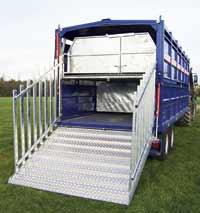
While the LAMMA show has traditionally had a strong arable flavour, more and more livestock farmers (and livestock equipment makers) are attending. With that in mind, Peter Hill provides a round-up of purpose-built livestock transport trailers
With farms becoming bigger and farmers taking on more distant pastures, owning a livestock trailer for moving animals from one location to another has become all but essential.
There is no shortage of choice – from dedicated low-loading designs to lift-off stock boxes that make good use of a bale trailer that would otherwise be left to stand idle for much of the year.
In both cases, the devil is in the detail. Building a decent trailer that can be loaded with cattle, sheep or pigs for occasional journeys between field and yard is relatively straightforward. It’s the way internal fixtures and fittings are built and installed that can make all the difference to the people using them.
Drop-bolt versus slam-shut internal divisions; ramp gates with spring assistance; sheep decking that folds away or is stored in the roof space; access door and viewing panel options; hydraulic main ramp and sheep deck operation; lift-off or jack-up container removal; an underfloor slurry tank – these are all features that producers can add to or subtract from the manufacturers’ standard build.
AW Engineering’s standard Stock Container comes in 6.7m and 7.9m (22ft and 26ft) lengths and is constructed using a steel frame clad with flat aluminium panels that is designed to sit snugly on a bale trailer.
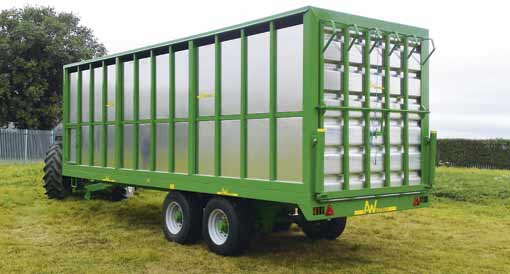
A welded aluminium floor can be added, together with an underfloor effluent tank and sheep decks that come with an additional inspection door and extra line of ventilation panels. Standard internal lighting helps on dark mornings and evenings.
Bailey Trailers’ Stock Box is built to suit the host trailer, to which it is secured using four stout straps. Main ramp gates are spring-assisted and optional sheep decks are available.
The 5m (16ft) 90LT and 6m (20ft) 100LT livestock trailers from Bateson come with a fully galvanised lift-off body sitting on an aluminium treadplate floor.
Corner sockets at both ends take ladder frames for maximum capacity and stability when hauling bales and there is a 1.2m (4ft) deck extension available for this activity.
Demounting jacks save lifting the body with a loader and extra internal dividing gates are available to supplement the one that comes as standard.
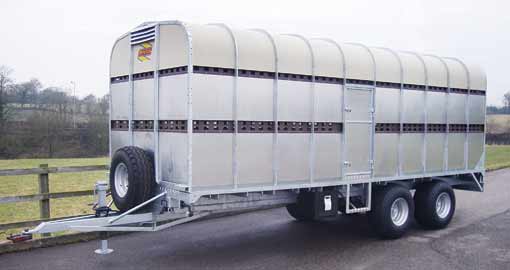
Biggest of two tractor-towed stock trailers from Bateson is the 6m (20ft) 100LT.
Cherry Products’ livestock trailer comes in three standard sizes – 6m, 7.6m and 9m (20ft, 25ft and 30ft) – all running on tandem beam axles with leaf-spring suspension, as is pretty much common practice with all such trailers.
Traditional wooden gates swing out to line the loading ramp and aluminium mid-height decking can be added for producers wanting to move sheep.
Steel gates on a profiled steel welded body are used on the single-deck stock trailer from AA Henton. The sides are topped by a simple steel frame clad in flexible plastic as protection from the elements.
Graham Edwards Trailers produces its demountable Livestock Containers in four sizes from 4.8m to 7.3m (16-24ft).
The alloy-bodied units come complete with alloy floor and flapped ventilation panels, and fold-away sheep decking is also available. The containers can be supplied to fit an existing trailer or a Wolds Trailers flat bed.
The new Country-Line from Houghtons-Parkhouse is designed to bridge the gap between conventional farm livestock trailers and commercial transporters.
Its monocoque construction alloy body – mounted on a steel chassis – is wider than usual at 2.53m (8ft 4in) so that cattle can stand cross-ways. The company’s safety lever lock gate system is used for the divisions, together with alloy loading gates and a built-in slurry tank.
The trailer can be built in sizes from 7.32m to 10.36m (24-34ft) with a choice of polished alloy or silver/grey paint finishes and in single or twin-deck configurations, the latter with a hydraulic ramp to decking stored in the roof.
A big choice of options, including integrated and lift-off bodies, is available for the Hudson Trailers livestock range. Sizes start at 5.5m (18ft) and increase in 0.6m (2ft) increments to 9.75m (32ft), with the largest models running on three axles.
Fold-away sheep decks, hydraulic ramp operation, anti-lock air brakes and a sprung drawbar are among options.
Body construction comprises galvanised steel uprights clad with aluminium panels, with an open section at the top of the front panel providing a viewing window. A tank beneath the floor collects effluent and washings through a grid to the rear of the trailer that can be lifted for cleaning.
Marshall gives buyers of its demountable livestock container a choice of aluminium or steel construction – the former being lighter and more corrosion resistant but more expensive.
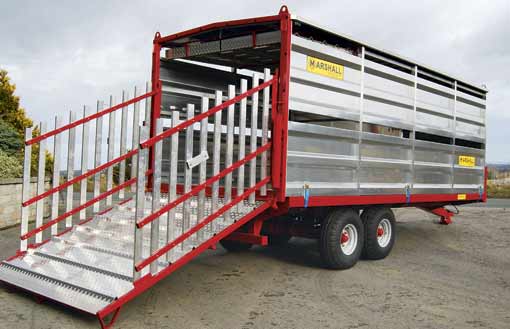
There are three standard sizes in each case: 6.4m, 7.62m and 8.5m (21ft, 25ft and 28ft) complete with a built-in floor.
Held in place on a flat-bed trailer by four or six straps, the container can have aluminium sheep decking and cross gates mounted on supports 45cm (18in) apart.
The welded all-aluminium lift-off Livestock Floats from Stewart Trailers come in sizes from 4.87m to 10.3m (16-34ft) and in “cattle” and “sheep” versions.
There are two sheep models – Standard Build with 0.6m (2ft) deck sections stored in the roof and Commercial with fold-away decking. The latter also has fixed-position dividing doors, cattle doors with slam-shut catches and optional hydraulic run-up ramp to the sheep deck.
Internal lighting and an effluent tank are among options for all versions, which are built by welding profiled aluminium sheet to box section uprights spaced 1.15m (3ft 8in) apart and which are welded to the treadplate floor for an easily-cleaned, strong and durable structure.
The demountable cattle/sheep box from Philip Watkins sits on a low-riding, 990mm deck height trailer with sprung drawbar. Underslung boxes provide storage for sawdust, clothing and other essentials.
Double vents and access doors are part of the twin deck configuration, with the aluminium upper deck sections stored in the roof and accessed via a ramp that, like the main ramp, is raised and lowered using hydraulic power.
Being able to load and unload at ground level with no need for a ramp is the key attraction of dedicated livestock trailers.
A newcomer to the market, Craftsman Agricultural, produces four standard sizes from 5.6m to 8.85m (18ft 4in to 29ft) with a choice of side heights to suit pigs, sheep and cattle.
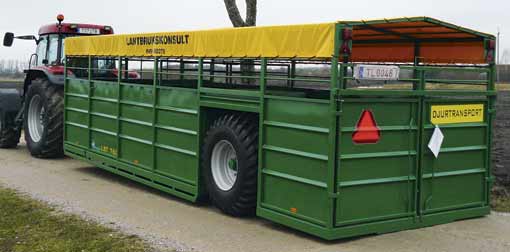
Large diameter flotation tyres are installed for easy towing and decent load capacity, and Craftsman is developing a weighing system that utilises the hydraulic lift-lower mechanism for the axle.
One-off specialist Dave Bunning Engineering produces an open-topped pig trailer with 80cm (33in) sides and central partition doors and a cattle version with 1.2m (4ft) sheet steel sides topped with rails to 1.8m (6ft) and a plastic canopy.
Seam welds throughout and angled tops to the wheel arches are said to add strength and a safe environment for transporting animals.
A non-slip rubber resin floor features in Joskin’s Betimax stock transporters to give animals a surer footing.
The trailer is a monocoque construction in galvanised steel; 5m and 6m (16ft 5in and 20ft) versions run on a single axle, while the 7.5m and 9m (24ft 8in and 29ft 6in) models – the latter carrying a dozen cattle – run on tandem axles.
Grippy rubber also lines Rolland’s hydraulic stock trailer, which has full-width rear doors and telescopic loading gates that can be stowed behind the doors or along the sides of the trailer.
It also features an internal partition slung from roof rails that can be moved to any position within the all-welded steel body, which comes in half a dozen sizes from 4.6m to 8.5m (15ft to 28ft).

